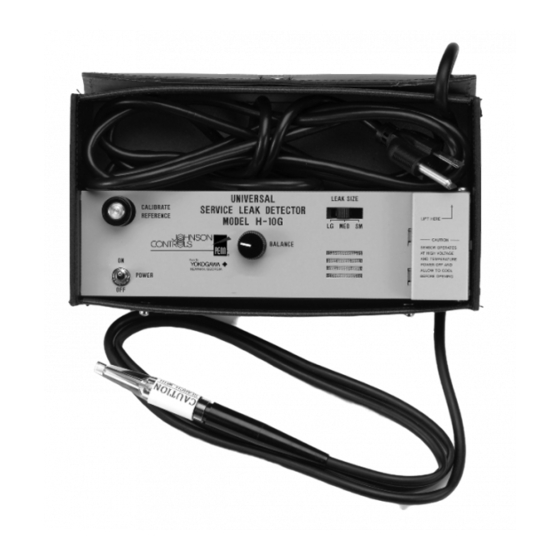
Table of Contents
Advertisement
Quick Links
RLD-H10G Refrigerant Leak Detectors
The RLD-H10G is a professional grade leak detector
for use by refrigeration and air conditioning
technicians. This detector senses all CFC, HCFC, and
HFC refrigerants and blends, such as R12, R502, R22,
R404a, R507, and R134a, among others. The
RLD-H10G plugs into a 120 VAC outlet. A full line of
accessories and maintenance kits is also available,
including replacement sensors, tune-up kits, probe
extensions, and leak vials.
Positive Ion Emission
Heated Diode Sensor
Halogen Selective Sensing
High Quality Air Pump
Visual and Audible Signal
Exceeds SAE J1627
Moving Probe Specification
External Calibration Source
© 1996 Johnson Controls, Inc.
Part No. 24-7929-39, Rev. A
Code No. LIT-125602
Features and Benefits
Provides the most sensitivity available today, while
still detecting all halogenated refrigerant gases
Eliminates many sources of possible false alarms
due to background contamination
Supplies constant air flow to sensor so it responds
quickly to leaks; also helps sensor recover quickly
after exposure to refrigerant so leak can be verified
Facilitates sensing in noisy equipment rooms with
360° visibility and piercing tone;
Frequency of noise/light indicates magnitude of leak
Minimizes service time because the leak is found the
first time, is verifiable, and the fix can be confirmed
Indicates when the sensor is working properly and
serves as a reference point to judge leak size
FANs 125, 121
Product/Technical Bulletin RLD-H10G
Figure 1: RLD-H10G Leak Detector
Issue Date 0396
1
Advertisement
Table of Contents

Subscribe to Our Youtube Channel
Summary of Contents for Johnson Controls RLD-H10G
- Page 1 HFC refrigerants and blends, such as R12, R502, R22, R404a, R507, and R134a, among others. The RLD-H10G plugs into a 120 VAC outlet. A full line of accessories and maintenance kits is also available, including replacement sensors, tune-up kits, probe extensions, and leak vials.
- Page 2 Extension sensitivity and capabilities to meet your service needs today and for the years to come. The RLD-H10G is intended principally as a service technician’s tool. This detector has the capability to detect small amounts of halogenated gases, including chlorine and fluorine based refrigerants and blends.
- Page 3 When the sensor is warm, the light and sound indication should idle at around three or four beats Figure 8: RLD-H10G Faceplate (Sensor heat control per second. The balance control (see Figure 8) adjustment is on the bottom of the unit.) may be used to adjust the idle rate.
- Page 4 Maintenance section) to retain airflow and sensitivity. 4. If the RLD-H10G does not respond to the leak vial, make sure there is liquid in the bottle. If the unit • Wipe all surfaces to be tested with a clean, dry still does not respond to the leak, increase the cloth.
- Page 5 The sensor is a plug-in unit that is thrown away when particles and moisture, replace the filter as it becomes expended. It needs replacement when the RLD-H10G dirty. With moderate use (15-30 minutes per day), no longer responds to the leak vial, even with the replacing the filter once a month is recommended.
- Page 6 (on the bottom of the unit) 1/16th of a turn clockwise. Allow a minute for the sensor to heat, then repeat calibration. Audio normal; probe lamp Burned-out or damaged Return unit to your Johnson Controls/PENN representative. does not flash probe lamp Responds continuously in all...
- Page 7 Replacement leak vial (contains enough refrigerant to last approximately six months) epair Non-Warranty Repairs Should it become necessary to repair your RLD-H10G, please contact your Johnson Units that are no longer under warranty will be Controls/PENN representative. repaired to factory specifications for a nominal fee.
- Page 8 The performance specifications are nominal and conform to acceptable industry standards. For application at conditions beyond these specifications, consult the local Johnson Controls office. Johnson Controls, Inc. shall not be liable for damages resulting from misapplication or misuse of its products.










Need help?
Do you have a question about the RLD-H10G and is the answer not in the manual?
Questions and answers